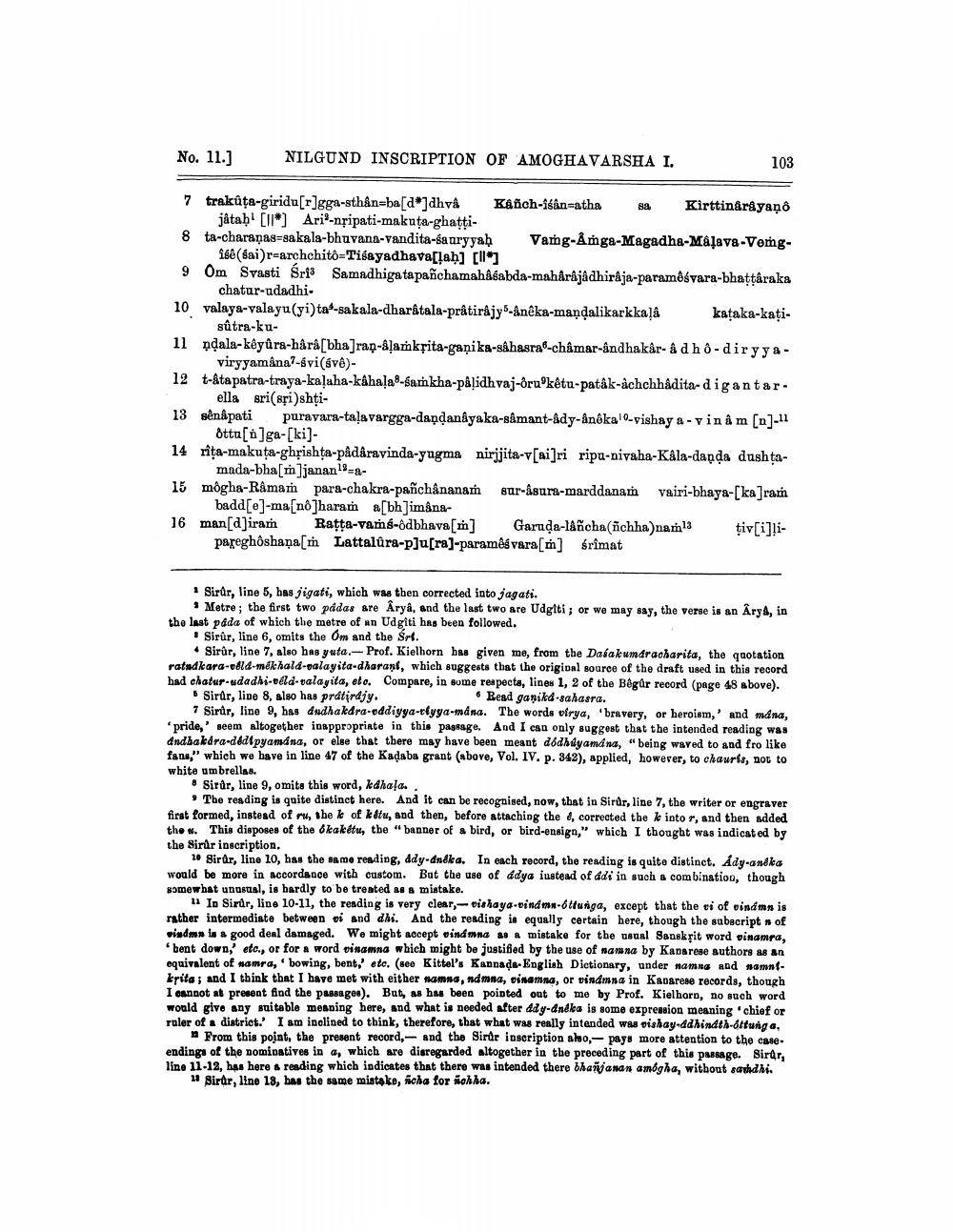________________
No. 11.)
NILGUND INSCRIPTION OF AMOGHAVARSHA I.
103
7 trakuța-giridu[r]gga-sthån=ba[a ]dhvá Kanch-Isan-atha sa Kirttinarayaņo
játah' [II*) Ari-nțipati-makuța-ghatti8 ta-charanas-sakala-bhuvana-vandita-sanryyah Vamg-Åmga-Magadha-Majava-Veng
16e (Sai)r-archchitô=Tiśeyadhava[lah] [ll] 9 Om Svasti Sri Samadhiga tapañchamaha abda-mahârâjâdhiraja-paramāśvara-bhattáraka
chatur-udadhi. 10 valaya-valayu(yi)ta-sakala-dharátala-prátirajyo-Aneka-maņdalikarkkaļ kataka-kați
sûtra-ku11 ndala-k@yara-hara[bha]rap-kļarnkrita-gaạika-s&hasrab-châmar-åndhakar- & dho-diryya
viryyamâna?-Svi(sve)12 t-atapatra-traya-kaļaha-kâhala-Samkha-pålidhvaj-ôruokêtu-patak-achchhadita-digantar.
ella sri(spi)shti13 sênápati puravara-taļavargga-daņdanayaka-sâmant-ady-ânêkal-vishay a-vinâ m (n)-11
ottu[]ga-[ki]14 rîța-makuța-ghrishta-pådäravinda-yugma nirjjita-v [ai]ri ripu-nivaha-Kala-danda dushta
mada-bha[m]janan-a15 môgha-Ramar para-chakra-pañchânanaṁ sur-Asura-marddanam vairi-bhaya-[ka]ram
badd[e]-ma[no]haram a[bh]imana16 man[aliram Ratta-vams-odbhava[m] Garuda-lañchaîchha)naml3 tiv[i]!i
pareghoshaņa[m Lattalûra-p]u[ra]-paramê vara[m] śrîmat
• Sirûr, line 5, has jigati, which was then corrected into jagati.
• Metre; the first two padas are Åryd, and the last two are Udgiti; or we may say, the verse is an Ary4, in the last pada of which the metre of an Udgiti has been followed.
• Sirûr, line 6, omits the Om and the Srt.
• Sirûr, line 7, also has yuta.-Prof. Kielhorn bas given me, from the Daiakundracharita, the quotation ratedkara-cold-mdkhald-palagita-dharan, which suggests that the original source of the draft used in this record had chatur-udadhi-reld-ralagita, eto. Compare, in some respecta, lines 1, 2 of the Begur record (page 48 above). 5 Sirûr, line 8, also has prátirdjy.
Read ganika-sahasra. 7 Sirur, line 9, has dudhakdra-oddiyya-efyga-mana. The words ofrya, 'bravery, or heroism,' and mana, pride, seem altogether inappropriate in this passage. And I can only suggest that the intended reading was andbakdra-dedi pyamdna, or else that there may have been meant dodhyamdna, "being waved to and fro like fans," which we have in line 47 of the Kadaba grant (above, Vol. IV. p. 342), applied, however, to chauris, not to white umbrellas.
• Sirar, line 9, omits this word, kdhala..
• The reading is quite distinct here. And it can be recognised, now, that in Sirûr, line 7, the writer or engraver first formed, instead of ru, tbe k of kitu, and then, before attaching the d, corrected the k intor, and then added thes. This disposes of the Okakétu, tbe "banner of a bird, or bird-ensigo," which I thought was indicated by the Sirar inscription.
• Sirar, line 10, has the same reading, ddy-dndka. In each record, the reading is quito distinct. Ady-anéka would be more in accordance with custom. But the use of ddya instead of ddi in such a combination, though somewhat unusual, is hardly to be treated as a mistake.
11 In Sirur, line 10-11, the reading is very clear,- vishaya-vindow.olturiga, except that the ti of vindms is rather intermediate between vi and dm. And the reading is equally certain here, though the subscript of vindms is a good deal damaged. We might accept vind mns as a mistake for the usual Sanskrit word vinama,
bent down,' etc., or for a word vinamna which might be justified by the use of namna by Kadarese authors as an eguivalent of samra, bowing, bent, etc. (see Kittel's Kannads-English Dictionary, under namng and samn. krita; and I think that I have met with either namns, Admna, vinama, or pindmsa in Kaparene records, though I cannot at present find the passages). But, as has been pointed out to me by Prof. Kielhorn, no such word would give any suitable meaning here, and what is needed after ddy-dndka is some expression meaning chief or ruler of a district. I am inclined to think, therefore, that what was really intended was vishay.ddhindth-ottunga,
From this point, the present record, and the Sirur inscription alo,- pays more attention to the case. endings of the nominatives in a, which are disregarded altogether in the preceding part of this passage. Sirar, line 11-12, has here s reading which indicates that there was intended there bhawanan ambgha, without saddhi.
u Birur, lino 18, has the same mistake, ficha for siehha.




